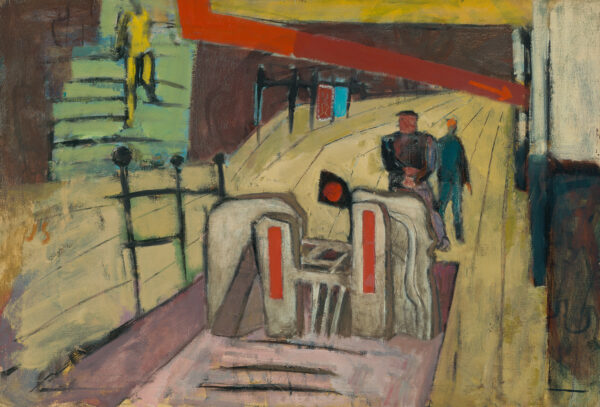
42nd St. Shuttle
Solman, Joseph
1937
Artwork Information
-
Title:
42nd St. Shuttle
-
Artist:
Solman, Joseph
-
Artist Bio:
American (born in Russia), 1909–2008
-
Date:
1937
-
Medium:
Oil on canvas
-
Dimensions:
24 x 35 inches
-
Credit Line:
Wichita Art Museum, Museum purchase, Friends of the Wichita Art Museum
-
Object Number:
1983.16
-
Display:
Not Currently on Display
About the Artwork
Joseph Solman
American (born in Russia) 1909–2008
42nd St. Shuttle, 1937
Oil on canvas
Wichita Art Museum, Museum purchase, Friends of the Wichita Art Museum
1983.16
Beneath New York City’s well known 42nd Street, one short section of subway operates to connect two of the main branches of the extensive New York subway system. The underground station there is dingy and drab and late at night it is almost entirely deserted. One wonders why such a subject would be chosen as the theme for a work of art. Yet it is the artist who has the unique capability of finding beauty and mystery in the most unexpected places. This explains why the American artist Joseph Solman executed this 1937 painting, 42nd Street Shuttle.
What we see here is a view of the underground platform and an emergency train bumper with a red stop signal marking the end of the shuttle line. Nearby stand two men, one a subway workman and the other perhaps a passenger waiting for the shuttle to arrive. In the upper left is seen a passenger descending the stairs leading down from ground level.
In no sense, however, is this a literal representation of the underground, for the forms depicted — all heavily outlined in black — are expressively suggested rather than accurately described, thus allowing the viewer’s imagination to come into play and complete the scene. Moreover, although such traditional spatial cues as receding lines and receding masses are clearly in evidence, Solman has intentionally distorted the overall space encompassed here by exaggerating the tilt of the platform floor as it extends into the distance, thereby charging the composition with a dynamic quality that echoes the nature of the setting itself.
But such energy derives even more from Solman’s use of rich and boldly contrasting colors. Solman has always been a strong colorist and in this work, by means of color control and the use of modulated saturations of red, he has created a vibrant and lively space, totally independent of subject matter. And that sense of aliveness achieved by color usage is further intensified by the radiant glow emanating from many of the forms edged with a narrow fringe of green or turquoise blue.
What is especially significant about this work is that Solman has produced the equivalent of an abstract expressionist painting a full decade before the abstract expressionist movement came to dominate the American art scene, but without abandoning identifiable forms. At the same time, the strong flat geometric shapes appearing throughout the composition, and in particular such signs and emblems as the circular stop light and the arrow on the long diagonal red band, suggest features of what will later be assimilated as image-types used by Pop and Photo-Realist artists.
Solman was born in 1909 in Vitebsk, Russia but settled with his family in 1912 in Jamaica, Long Island. He attended night classes at the National Academy. During the Depression, he worked on the WPA and served as editor of the Artist’s Union publication Art Front.